warning light SATURN ASTRA 2008 Owner's Manual
[x] Cancel search | Manufacturer: SATURN, Model Year: 2008, Model line: ASTRA, Model: SATURN ASTRA 2008Pages: 304, PDF Size: 1.92 MB
Page 205 of 304
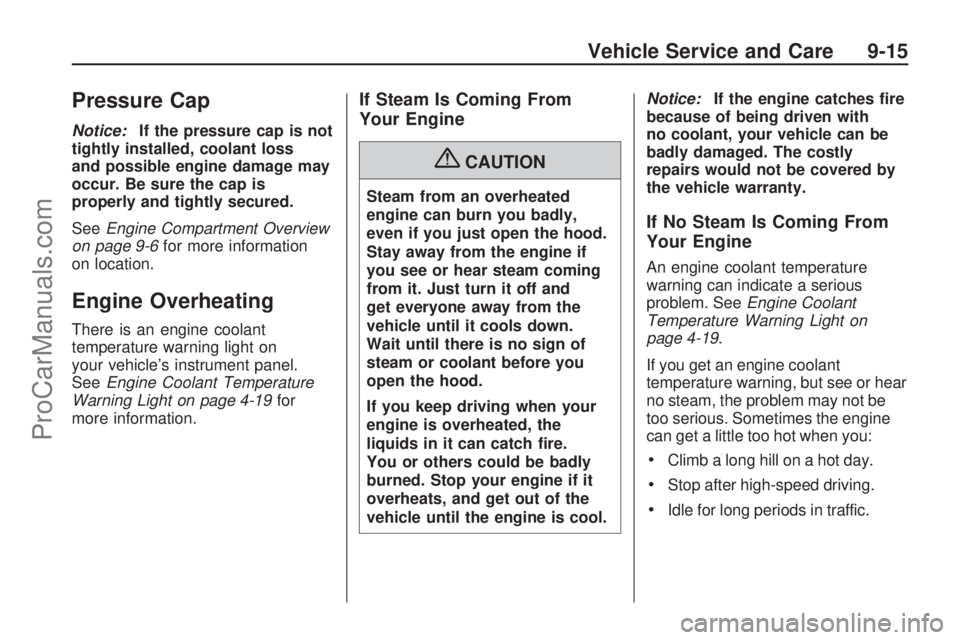
Pressure Cap
Notice:If the pressure cap is not
tightly installed, coolant loss
and possible engine damage may
occur. Be sure the cap is
properly and tightly secured.
SeeEngine Compartment Overview
on page 9-6for more information
on location.
Engine Overheating
There is an engine coolant
temperature warning light on
your vehicle’s instrument panel.
SeeEngine Coolant Temperature
Warning Light on page 4-19for
more information.
If Steam Is Coming From
Your Engine
{CAUTION
Steam from an overheated
engine can burn you badly,
even if you just open the hood.
Stay away from the engine if
you see or hear steam coming
from it. Just turn it off and
get everyone away from the
vehicle until it cools down.
Wait until there is no sign of
steam or coolant before you
open the hood.
If you keep driving when your
engine is overheated, the
liquids in it can catch �re.
You or others could be badly
burned. Stop your engine if it
overheats, and get out of the
vehicle until the engine is cool.Notice:If the engine catches �re
because of being driven with
no coolant, your vehicle can be
badly damaged. The costly
repairs would not be covered by
the vehicle warranty.
If No Steam Is Coming From
Your Engine
An engine coolant temperature
warning can indicate a serious
problem. SeeEngine Coolant
Temperature Warning Light on
page 4-19.
If you get an engine coolant
temperature warning, but see or hear
no steam, the problem may not be
too serious. Sometimes the engine
can get a little too hot when you:
Climb a long hill on a hot day.
Stop after high-speed driving.
Idle for long periods in traffic.
Vehicle Service and Care 9-15
ProCarManuals.com
Page 240 of 304
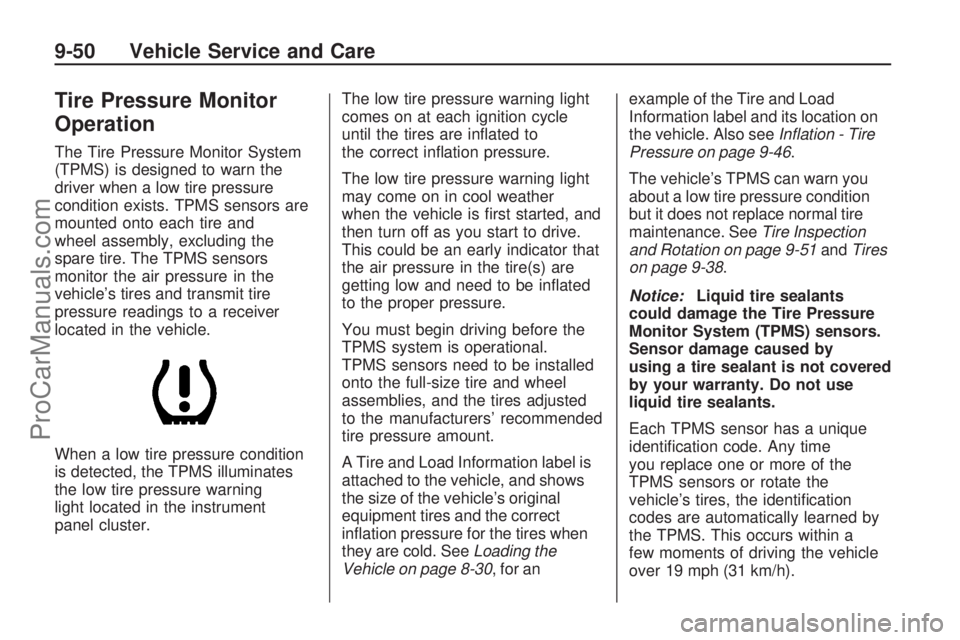
Tire Pressure Monitor
Operation
The Tire Pressure Monitor System
(TPMS) is designed to warn the
driver when a low tire pressure
condition exists. TPMS sensors are
mounted onto each tire and
wheel assembly, excluding the
spare tire. The TPMS sensors
monitor the air pressure in the
vehicle’s tires and transmit tire
pressure readings to a receiver
located in the vehicle.
When a low tire pressure condition
is detected, the TPMS illuminates
the low tire pressure warning
light located in the instrument
panel cluster.The low tire pressure warning light
comes on at each ignition cycle
until the tires are in�ated to
the correct in�ation pressure.
The low tire pressure warning light
may come on in cool weather
when the vehicle is �rst started, and
then turn off as you start to drive.
This could be an early indicator that
the air pressure in the tire(s) are
getting low and need to be in�ated
to the proper pressure.
You must begin driving before the
TPMS system is operational.
TPMS sensors need to be installed
onto the full-size tire and wheel
assemblies, and the tires adjusted
to the manufacturers’ recommended
tire pressure amount.
A Tire and Load Information label is
attached to the vehicle, and shows
the size of the vehicle’s original
equipment tires and the correct
in�ation pressure for the tires when
they are cold. SeeLoading the
Vehicle on page 8-30, for anexample of the Tire and Load
Information label and its location on
the vehicle. Also seeInflation - Tire
Pressure on page 9-46.
The vehicle’s TPMS can warn you
about a low tire pressure condition
but it does not replace normal tire
maintenance. SeeTire Inspection
and Rotation on page 9-51andTires
on page 9-38.
Notice:Liquid tire sealants
could damage the Tire Pressure
Monitor System (TPMS) sensors.
Sensor damage caused by
using a tire sealant is not covered
by your warranty. Do not use
liquid tire sealants.
Each TPMS sensor has a unique
identi�cation code. Any time
you replace one or more of the
TPMS sensors or rotate the
vehicle’s tires, the identi�cation
codes are automatically learned by
the TPMS. This occurs within a
few moments of driving the vehicle
over 19 mph (31 km/h).
9-50 Vehicle Service and Care
ProCarManuals.com
Page 241 of 304

TPMS Malfunction Light
The TPMS will not function properly
if one or more of the TPMS
sensors are missing or inoperable.
When the system detects a
malfunction, the low tire warning
light �ashes for about one minute
and then stays on for the remainder
of the ignition cycle. Some of the
conditions that can cause the
malfunction light to come on are:
One of the road tires has been
replaced with the spare tire. The
spare tire does not have a TPMS
sensor. The TPMS malfunction
light and DIC message should go
off once you re-install the road tire
containing the TPMS sensor.
One or more TPMS sensors are
missing or damaged. The TPMS
malfunction light should go off
after the TPMS sensors are
installed and the vehicle is
driven for a few moments over
19 mph (31 km/h). See your
dealer/retailer for service.
Replacement tires or wheels do
not match the vehicle’s original
equipment tires or wheels. Tires
and wheels other than those
recommended for the vehicle
could prevent the TPMS from
functioning properly. SeeBuying
New Tires on page 9-54.
Operating electronic devices or
being near facilities using radio
wave frequencies similar to the
TPMS could cause the TPMS
sensors to malfunction.
If the TPMS is not functioning it
cannot detect or signal a low tire
condition. See your dealer/retailer
for service if the TPMS malfunction
light comes on and stays on.
Tire Inspection and
Rotation
Inspect tires regularly for signs of
wear or damage. Also inspect the
spare tire. For more information
on tire inspection, seeWhen It Is
Time for New Tires on page 9-53.
Rotating vehicle tires helps them
to wear evenly and keeps the
vehicle performing like it did
when tires were new.
Rotate the tires and check
wheel alignment approximately
every 5,000 to 8,000 miles
(8 000 to 13 000 km) or when
unusual tire wear is noted.
See “Scheduled Maintenance”
in the Index of the “Limited
Warranty, Maintenance
and Owner Assistance
Information” manual for more
information. Also check the
wheels for damage, seeWheel
Replacement on page 9-58
for more information.
Vehicle Service and Care 9-51
ProCarManuals.com
Page 295 of 304
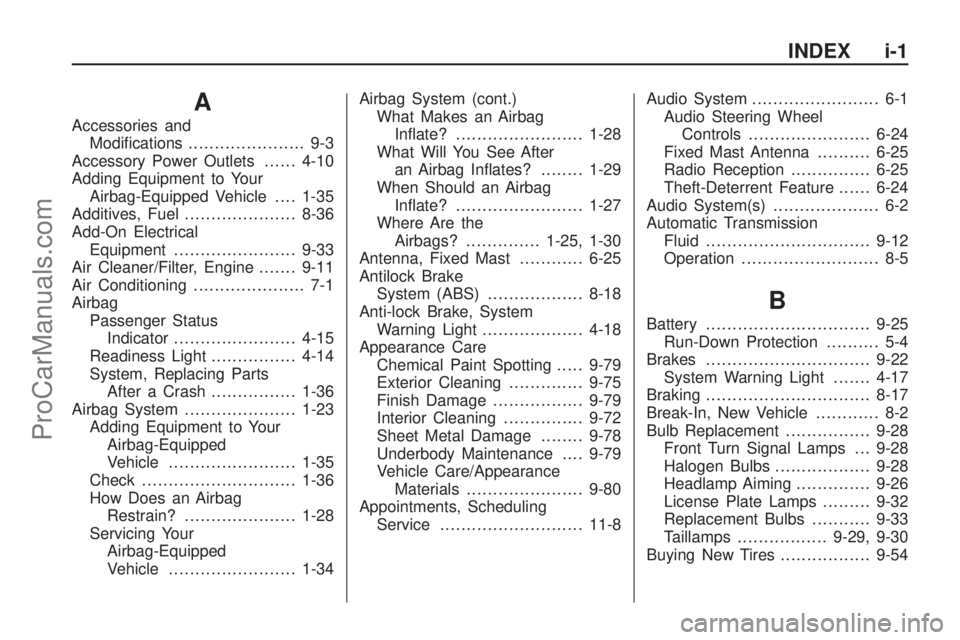
A
Accessories and
Modi�cations...................... 9-3
Accessory Power Outlets......4-10
Adding Equipment to Your
Airbag-Equipped Vehicle....1-35
Additives, Fuel.....................8-36
Add-On Electrical
Equipment.......................9-33
Air Cleaner/Filter, Engine.......9-11
Air Conditioning..................... 7-1
Airbag
Passenger Status
Indicator.......................4-15
Readiness Light................4-14
System, Replacing Parts
After a Crash................1-36
Airbag System.....................1-23
Adding Equipment to Your
Airbag-Equipped
Vehicle........................1-35
Check.............................1-36
How Does an Airbag
Restrain?.....................1-28
Servicing Your
Airbag-Equipped
Vehicle........................1-34Airbag System (cont.)
What Makes an Airbag
In�ate?........................1-28
What Will You See After
an Airbag In�ates?........1-29
When Should an Airbag
In�ate?........................1-27
Where Are the
Airbags?..............1-25, 1-30
Antenna, Fixed Mast............6-25
Antilock Brake
System (ABS)..................8-18
Anti-lock Brake, System
Warning Light...................4-18
Appearance Care
Chemical Paint Spotting.....9-79
Exterior Cleaning..............9-75
Finish Damage.................9-79
Interior Cleaning...............9-72
Sheet Metal Damage........9-78
Underbody Maintenance....9-79
Vehicle Care/Appearance
Materials
......................9-80
Appointments, Scheduling
Service...........................11-8Audio System........................ 6-1
Audio Steering Wheel
Controls.......................6-24
Fixed Mast Antenna..........6-25
Radio Reception...............6-25
Theft-Deterrent Feature......6-24
Audio System(s).................... 6-2
Automatic Transmission
Fluid...............................9-12
Operation.......................... 8-5
B
Battery...............................9-25
Run-Down Protection.......... 5-4
Brakes...............................9-22
System Warning Light.......4-17
Braking...............................8-17
Break-In, New Vehicle............ 8-2
Bulb Replacement................9-28
Front Turn Signal Lamps . . . 9-28
Halogen Bulbs..................9-28
Headlamp Aiming..............9-26
License Plate Lamps.........9-32
Replacement Bulbs...........9-33
Taillamps.................9-29, 9-30
Buying New Tires.................9-54
INDEX i-1
ProCarManuals.com
Page 296 of 304
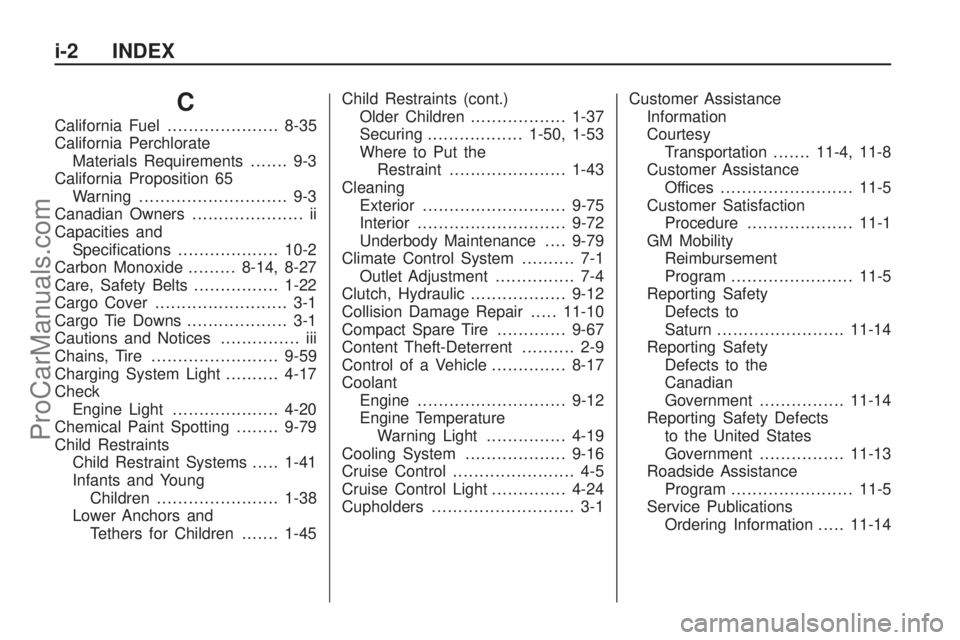
C
California Fuel.....................8-35
California Perchlorate
Materials Requirements....... 9-3
California Proposition 65
Warning............................ 9-3
Canadian Owners..................... ii
Capacities and
Speci�cations...................10-2
Carbon Monoxide.........8-14, 8-27
Care, Safety Belts................1-22
Cargo Cover......................... 3-1
Cargo Tie Downs................... 3-1
Cautions and Notices............... iii
Chains, Tire........................9-59
Charging System Light..........4-17
Check
Engine Light....................4-20
Chemical Paint Spotting........9-79
Child Restraints
Child Restraint Systems.....1-41
Infants and Young
Children.......................1-38
Lower Anchors and
Tethers for Children.......1-45Child Restraints (cont.)
Older Children..................1-37
Securing..................1-50, 1-53
Where to Put the
Restraint......................1-43
Cleaning
Exterior...........................9-75
Interior............................9-72
Underbody Maintenance....9-79
Climate Control System.......... 7-1
Outlet Adjustment............... 7-4
Clutch, Hydraulic..................9-12
Collision Damage Repair.....11-10
Compact Spare Tire.............9-67
Content Theft-Deterrent.......... 2-9
Control of a Vehicle..............8-17
Coolant
Engine............................9-12
Engine Temperature
Warning Light...............4-19
Cooling System...................
9-16
Cruise Control....................... 4-5
Cruise Control Light..............4-24
Cupholders........................... 3-1Customer Assistance
Information
Courtesy
Transportation.......11-4, 11-8
Customer Assistance
Offices.........................11-5
Customer Satisfaction
Procedure....................11-1
GM Mobility
Reimbursement
Program.......................11-5
Reporting Safety
Defects to
Saturn........................11-14
Reporting Safety
Defects to the
Canadian
Government................11-14
Reporting Safety Defects
to the United States
Government................11-13
Roadside Assistance
Program.......................11-5
Service Publications
Ordering Information.....11-14
i-2 INDEX
ProCarManuals.com
Page 297 of 304
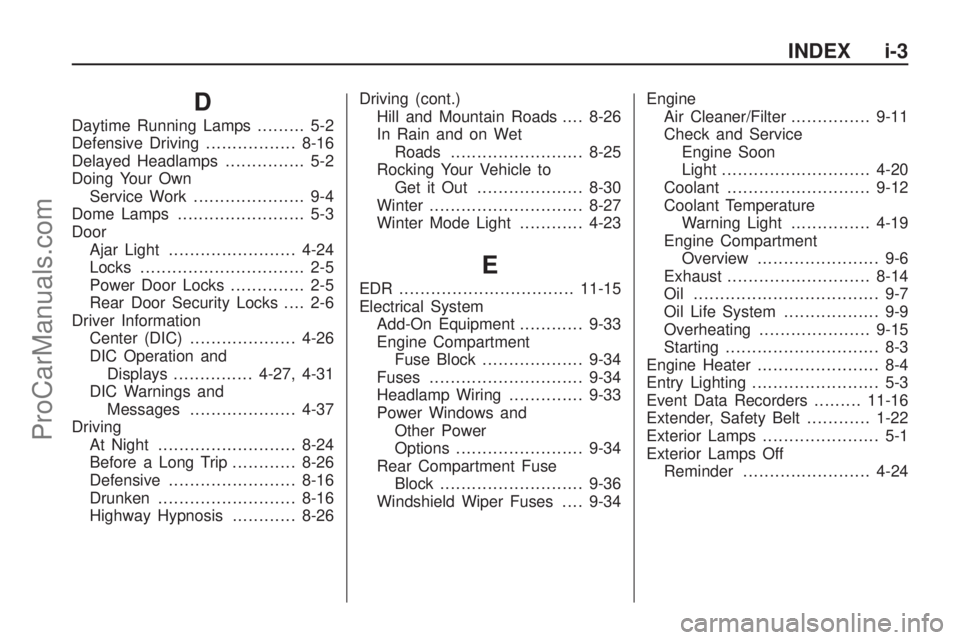
D
Daytime Running Lamps......... 5-2
Defensive Driving.................8-16
Delayed Headlamps............... 5-2
Doing Your Own
Service Work..................... 9-4
Dome Lamps ........................ 5-3
Door
Ajar Light........................4-24
Locks............................... 2-5
Power Door Locks.............. 2-5
Rear Door Security Locks.... 2-6
Driver Information
Center (DIC)....................4-26
DIC Operation and
Displays...............4-27, 4-31
DIC Warnings and
Messages....................4-37
Driving
At Night..........................8-24
Before a Long Trip............8-26
Defensive........................8-16
Drunken..........................8-16
Highway Hypnosis............8-26Driving (cont.)
Hill and Mountain Roads....8-26
In Rain and on Wet
Roads.........................8-25
Rocking Your Vehicle to
Get it Out ....................8-30
Winter.............................8-27
Winter Mode Light............4-23
E
EDR .................................11-15
Electrical System
Add-On Equipment............9-33
Engine Compartment
Fuse Block...................9-34
Fuses.............................9-34
Headlamp Wiring..............9-33
Power Windows and
Other Power
Options........................9-34
Rear Compartment Fuse
Block...........................9-36
Windshield Wiper Fuses....9-34Engine
Air Cleaner/Filter...............9-11
Check and Service
Engine Soon
Light............................4-20
Coolant...........................9-12
Coolant Temperature
Warning Light...............4-19
Engine Compartment
Overview....................... 9-6
Exhaust...........................8-14
Oil ................................... 9-7
Oil Life System.................. 9-9
Overheating.....................9-15
Starting............................. 8-3
Engine Heater....................... 8-4
Entry Lighting........................ 5-3
Event Data Recorders.........11-16
Extender, Safety Belt............1-22
Exterior Lamps...................... 5-1
Exterior Lamps Off
Reminder........................4-24
INDEX i-3
ProCarManuals.com
Page 298 of 304
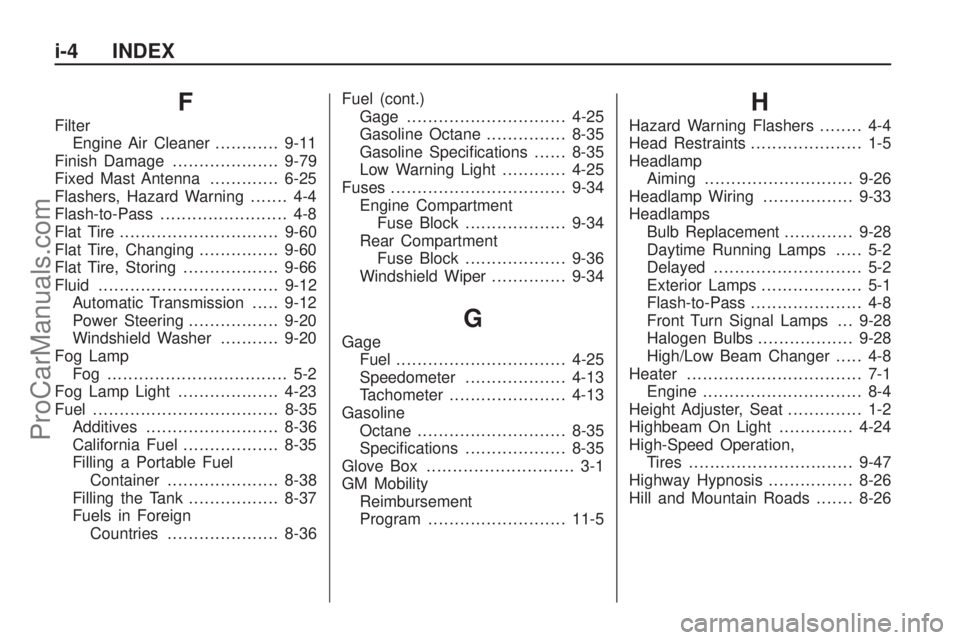
F
Filter
Engine Air Cleaner............9-11
Finish Damage....................9-79
Fixed Mast Antenna.............6-25
Flashers, Hazard Warning....... 4-4
Flash-to-Pass........................ 4-8
Flat Tire..............................9-60
Flat Tire, Changing...............9-60
Flat Tire, Storing..................9-66
Fluid..................................9-12
Automatic Transmission.....9-12
Power Steering.................9-20
Windshield Washer...........9-20
Fog Lamp
Fog .................................. 5-2
Fog Lamp Light...................4-23
Fuel...................................8-35
Additives.........................8-36
California Fuel..................8-35
Filling a Portable Fuel
Container.....................8-38
Filling the Tank.................8-37
Fuels in Foreign
Countries.....................8-36Fuel (cont.)
Gage ..............................4-25
Gasoline Octane...............8-35
Gasoline Speci�cations......8-35
Low Warning Light............4-25
Fuses.................................9-34
Engine Compartment
Fuse Block...................9-34
Rear Compartment
Fuse Block...................9-36
Windshield Wiper..............9-34
G
Gage
Fuel................................4-25
Speedometer...................4-13
Tachometer......................4-13
Gasoline
Octane............................8-35
Speci�cations...................8-35
Glove Box............................ 3-1
GM Mobility
Reimbursement
Program..........................11-5
H
Hazard Warning Flashers........ 4-4
Head Restraints..................... 1-5
Headlamp
Aiming ............................9-26
Headlamp Wiring.................9-33
Headlamps
Bulb Replacement.............9-28
Daytime Running Lamps..... 5-2
Delayed............................ 5-2
Exterior Lamps................... 5-1
Flash-to-Pass..................... 4-8
Front Turn Signal Lamps . . . 9-28
Halogen Bulbs..................9-28
High/Low Beam Changer..... 4-8
Heater................................. 7-1
Engine.............................. 8-4
Height Adjuster, Seat.............. 1-2
Highbeam On Light..............4-24
High-Speed Operation,
Tires...............................9-47
Highway Hypnosis................8-26
Hill and Mountain Roads.......8-26
i-4 INDEX
ProCarManuals.com
Page 299 of 304
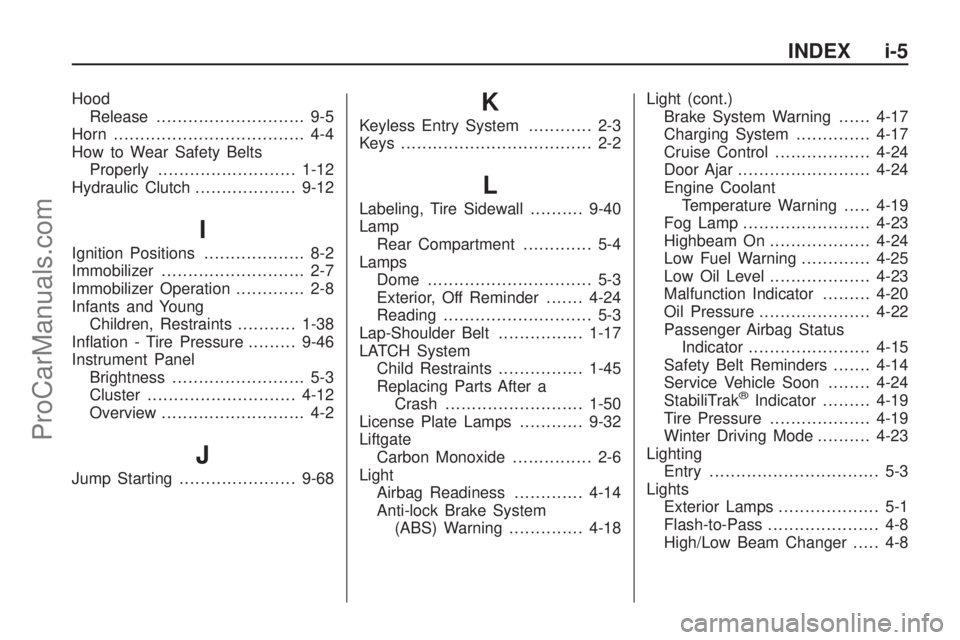
Hood
Release............................ 9-5
Horn .................................... 4-4
How to Wear Safety Belts
Properly..........................1-12
Hydraulic Clutch...................9-12
I
Ignition Positions................... 8-2
Immobilizer........................... 2-7
Immobilizer Operation............. 2-8
Infants and Young
Children, Restraints...........1-38
In�ation - Tire Pressure.........9-46
Instrument Panel
Brightness......................... 5-3
Cluster............................4-12
Overview........................... 4-2
J
Jump Starting......................9-68
K
Keyless Entry System............ 2-3
Keys.................................... 2-2
L
Labeling, Tire Sidewall..........9-40
Lamp
Rear Compartment............. 5-4
Lamps
Dome ............................... 5-3
Exterior, Off Reminder.......4-24
Reading............................ 5-3
Lap-Shoulder Belt................1-17
LATCH System
Child Restraints................1-45
Replacing Parts After a
Crash..........................1-50
License Plate Lamps............9-32
Liftgate
Carbon Monoxide............... 2-6
Light
Airbag Readiness.............4-14
Anti-lock Brake System
(ABS) Warning..............4-18Light (cont.)
Brake System Warning......4-17
Charging System..............4-17
Cruise Control..................4-24
Door Ajar.........................4-24
Engine Coolant
Temperature Warning.....4-19
Fog Lamp ........................4-23
Highbeam On...................4-24
Low Fuel Warning.............4-25
Low Oil Level...................4-23
Malfunction Indicator.........4-20
Oil Pressure.....................4-22
Passenger Airbag Status
Indicator.......................4-15
Safety Belt Reminders.......4-14
Service Vehicle Soon........4-24
StabiliTrak
®Indicator.........4-19
Tire Pressure...................4-19
Winter Driving Mode..........4-23
Lighting
Entry................................ 5-3
Lights
Exterior Lamps................... 5-1
Flash-to-Pass..................... 4-8
High/Low Beam Changer..... 4-8
INDEX i-5
ProCarManuals.com
Page 300 of 304
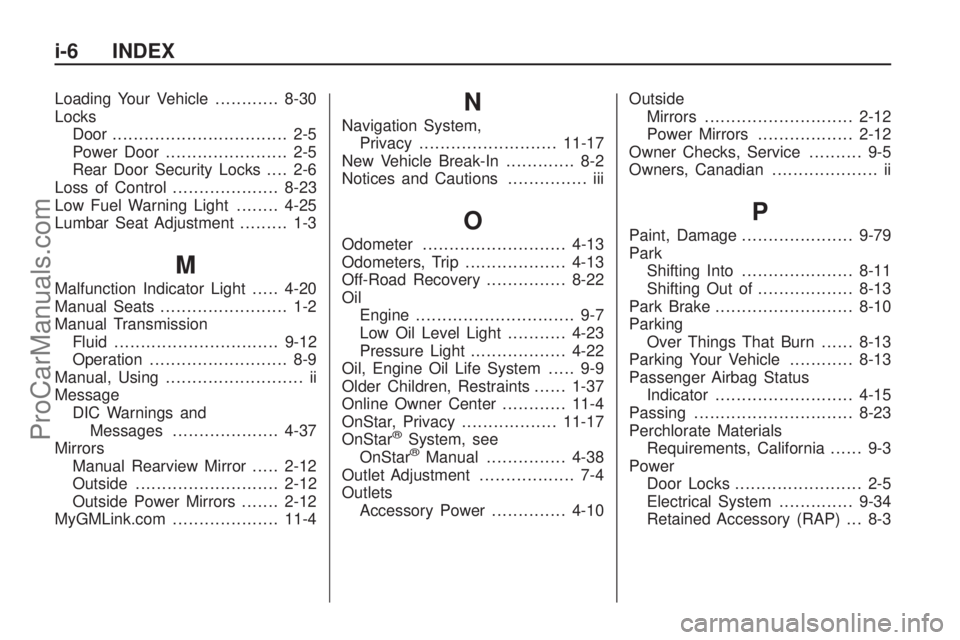
Loading Your Vehicle............8-30
Locks
Door ................................. 2-5
Power Door ....................... 2-5
Rear Door Security Locks.... 2-6
Loss of Control....................8-23
Low Fuel Warning Light........4-25
Lumbar Seat Adjustment......... 1-3
M
Malfunction Indicator Light.....4-20
Manual Seats........................ 1-2
Manual Transmission
Fluid...............................9-12
Operation.......................... 8-9
Manual, Using.......................... ii
Message
DIC Warnings and
Messages....................4-37
Mirrors
Manual Rearview Mirror.....2-12
Outside...........................2-12
Outside Power Mirrors.......2-12
MyGMLink.com....................11-4
N
Navigation System,
Privacy..........................11-17
New Vehicle Break-In............. 8-2
Notices and Cautions............... iii
O
Odometer...........................4-13
Odometers, Trip...................4-13
Off-Road Recovery...............8-22
Oil
Engine.............................. 9-7
Low Oil Level Light...........4-23
Pressure Light..................4-22
Oil, Engine Oil Life System..... 9-9
Older Children, Restraints......1-37
Online Owner Center............11-4
OnStar, Privacy..................11-17
OnStar
®System, see
OnStar®Manual...............4-38
Outlet Adjustment.................. 7-4
Outlets
Accessory Power..............4-10Outside
Mirrors............................2-12
Power Mirrors..................2-12
Owner Checks, Service.......... 9-5
Owners, Canadian.................... ii
P
Paint, Damage.....................9-79
Park
Shifting Into.....................8-11
Shifting Out of..................8-13
Park Brake..........................8-10
Parking
Over Things That Burn......8-13
Parking Your Vehicle............8-13
Passenger Airbag Status
Indicator..........................4-15
Passing..............................8-23
Perchlorate Materials
Requirements, California...... 9-3
Power
Door Locks........................ 2-5
Electrical System..............9-34
Retained Accessory (RAP) . . . 8-3
i-6 INDEX
ProCarManuals.com
Page 302 of 304
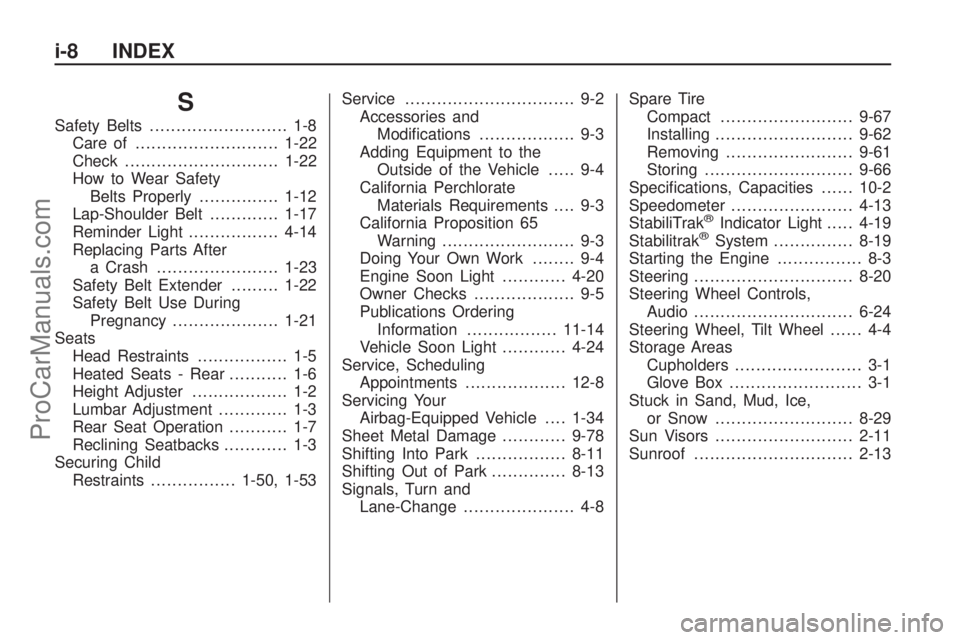
S
Safety Belts.......................... 1-8
Care of ...........................1-22
Check.............................1-22
How to Wear Safety
Belts Properly...............1-12
Lap-Shoulder Belt.............1-17
Reminder Light.................4-14
Replacing Parts After
a Crash.......................1-23
Safety Belt Extender.........1-22
Safety Belt Use During
Pregnancy....................1-21
Seats
Head Restraints................. 1-5
Heated Seats - Rear........... 1-6
Height Adjuster.................. 1-2
Lumbar Adjustment............. 1-3
Rear Seat Operation........... 1-7
Reclining Seatbacks............ 1-3
Securing Child
Restraints................1-50, 1-53Service................................ 9-2
Accessories and
Modi�cations.................. 9-3
Adding Equipment to the
Outside of the Vehicle..... 9-4
California Perchlorate
Materials Requirements.... 9-3
California Proposition 65
Warning......................... 9-3
Doing Your Own Work........ 9-4
Engine Soon Light............4-20
Owner Checks................... 9-5
Publications Ordering
Information.................11-14
Vehicle Soon Light............4-24
Service, Scheduling
Appointments...................12-8
Servicing Your
Airbag-Equipped Vehicle....1-34
Sheet Metal Damage............9-78
Shifting Into Park.................8-11
Shifting Out of Park..............8-13
Signals, Turn and
Lane-Change..................... 4-8Spare Tire
Compact.........................9-67
Installing..........................9-62
Removing
........................9-61
Storing............................9-66
Speci�cations, Capacities......10-2
Speedometer.......................4-13
StabiliTrak
®Indicator Light.....4-19
Stabilitrak®System...............8-19
Starting the Engine................ 8-3
Steering..............................8-20
Steering Wheel Controls,
Audio..............................6-24
Steering Wheel, Tilt Wheel...... 4-4
Storage Areas
Cupholders........................ 3-1
Glove Box......................... 3-1
Stuck in Sand, Mud, Ice,
or Snow..........................8-29
Sun Visors..........................2-11
Sunroof..............................2-13
i-8 INDEX
ProCarManuals.com